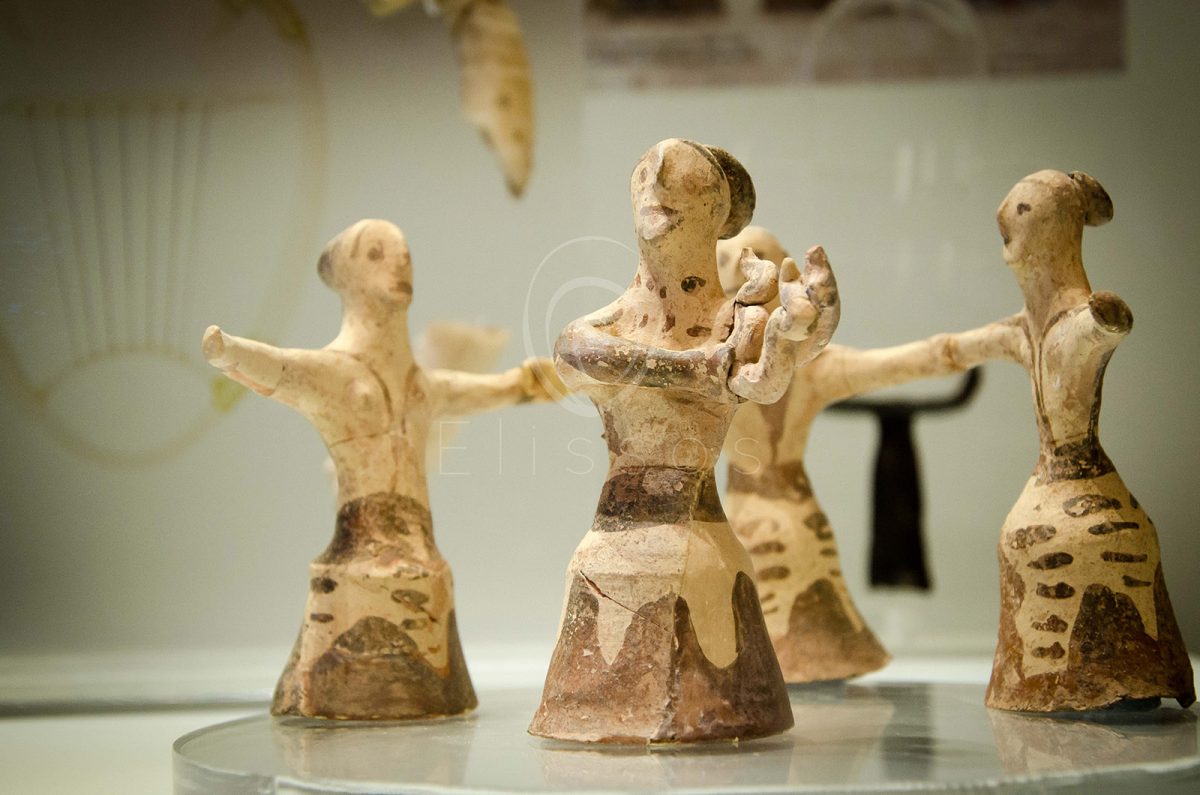Minoans, the first Dancers!

The dancing floor of “Ariadne of the lovely tresses”…
Evidence for circle dances in the Aegean comes from a variety of sites.
The first example comes from Crete in the Early Bronze Age. The settings of these
Dances were the Early Minoan cemeteries of south-central Crete, particularly in the region of the Mesara plain.
Zoomorphic and anthropomorphic figurines have been found inside and around tholos tombs, and a particular figurine from the site of Kamilari depicts four figures holding each other by the arms and shoulders, surrounded by a low wall decorated with Horns of Consecration. Most archaeologists concur that this group represents people dancing.
The construction of small courtyards, paved or not, first develops as well in the Early Minoan Period tholos tombs, such as at Platanos and Ayia Kyriaki, and continues into the Middle Minoan period,such as at the tombs of Apesokari. Similar enclosed, but unpaved areas are found at Kamilari and Moni Odigytrias. Thus during the Early Minoan period, we begin to see architectural spaces which could host the performance of circular dances, the existence of which is confirmed through figural representation.
During the Post Palatial period, roughly 1,500 years later the representation of the ritual Dance becomes more specific. This is a period when the island of Crete is believed to have been taken over by Mycenaeans from mainland Greece, who operated out of Knossos. During this period, both architectural and iconographical evidence again attest to the existence of the circle dance.
During Late Minoan period (c.1400–1350B.C.), architectural features were constructed which have been linked to the performance of dance by Professor Peter Warren in his excavations in 1982.
Such areas are situated west of the Unexplored Mansion and the Little Palace of Knossos, and roughly 350m northwest of the Palace of Knossos itself. The evidence consists of three circular-built platforms standing in open ground. The possibility that these platforms were used as dancing floors was put forward by the excavator on the basis of several criteria.
A number of seals found within the vicinity of the “Great Circular Building’ depicting women dancing or performing ritual actions. Engraved mason’s marks (sacred carvings) were also found on slabs on the “Small Circle” and the “Great Circle”. The excavator suggests that this particular mason’s marks were designed to symbolise the lines and zigzag movements of dancing.
During this same period on Crete, iconographical evidence for circular dances comes from the site of Palaikastro in the east of the island. The model shows three small terracotta women in long dresses dancing in a circle around a phorminx or lyre player, their arms held out from the shoulders.
Zoomorphic and anthropomorphic figurines have been found inside and around tholos tombs, and a particular figurine from the site of Kamilari depicts four figures holding each other by the arms and shoulders, surrounded by a low wall decorated with Horns of Consecration. Most archaeologists concur that this group represents people dancing.
The construction of small courtyards, paved or not, first develops as well in the Early Minoan Period tholos tombs, such as at Platanos and Ayia Kyriaki, and continues into the Middle Minoan period,such as at the tombs of Apesokari. Similar enclosed, but unpaved areas are found at Kamilari and Moni Odigytrias. Thus during the Early Minoan period, we begin to see architectural spaces which could host the performance of circular dances, the existence of which is confirmed through figural representation.
During the Post Palatial period, roughly 1,500 years later the representation of the ritual Dance becomes more specific. This is a period when the island of Crete is believed to have been taken over by Mycenaeans from mainland Greece, who operated out of Knossos. During this period, both architectural and iconographical evidence again attest to the existence of the circle dance.
During Late Minoan period (c.1400–1350B.C.), architectural features were constructed which have been linked to the performance of dance by Professor Peter Warren in his excavations in 1982.
Such areas are situated west of the Unexplored Mansion and the Little Palace of Knossos, and roughly 350m northwest of the Palace of Knossos itself. The evidence consists of three circular-built platforms standing in open ground. The possibility that these platforms were used as dancing floors was put forward by the excavator on the basis of several criteria.
A number of seals found within the vicinity of the “Great Circular Building’ depicting women dancing or performing ritual actions. Engraved mason’s marks (sacred carvings) were also found on slabs on the “Small Circle” and the “Great Circle”. The excavator suggests that this particular mason’s marks were designed to symbolise the lines and zigzag movements of dancing.
During this same period on Crete, iconographical evidence for circular dances comes from the site of Palaikastro in the east of the island. The model shows three small terracotta women in long dresses dancing in a circle around a phorminx or lyre player, their arms held out from the shoulders.
